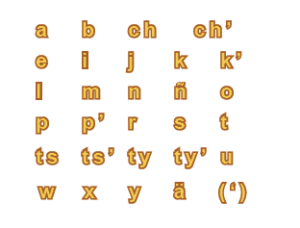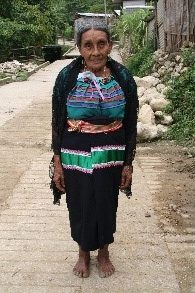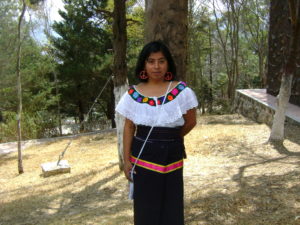Our language has different variants, and depending on the place in which it is spoken it can be identified as the dialect of Tila or of Tumbalá. Some words are different, but they have the same meaning. Here are some examples:
Tila Tumbalá Meaning
Tyuñ Xajlel Rock
Ch’ijch’um Ñi’uk’ chayote
Ch’ek’ajk Luty roasted corn
Yum Tatuch grandfather
Luty Loj twin
Mam Buts grandchild
Chonkol Woli to be doing (progressive)
Majlel Sam go
Yoke ja’as Ichija’as banana
Chakal Pits’il naked
K’uk’um Tsutsel feather
Tyejch Kej round and flat (classifier of shapes)
Toñel E’tyel work
Xä’bäl Käkäw Sa’ chocolate pozol
Xajk’ul Pats’ bean tamale
Xäk’ä’ Bu’lewaj bean tortilla
Sets’ Ch’ejew clay plate
Xk’aläl Xch’ok young woman
Bujk P’o’ clothing
Other words are not so different, but the pronunciation changes, for example
Momoñ Momoy Hierba Santa
Pusk’al Pusik’al heart
Semety Semejty comal
Yujmel Yunjel unlce
Jomoch’ Jomojch Joloche
Mep’ Ñep’ crab
Pejpem Pejpeñ butterfly
Ts’ijñ Ts’ijm yuca
Je’el Ja’el also
Ma’añ Ma’añik no, there aren’t
Ajñisañ Ajñesañ chase it!
k’änjol K’ajñol pillow
Xiye’ Xäye’ eagle
A’bälel Ak’lel night
Pijchik’ Pintsik’ zanate
Che’jk’o’ Ch’ejk’u’ woodpecker
The following audio was recorded by Silvestre Gómez Jiménez, a cultural promoter who worked in CELALI:


 a tree (standing) = juñtyejk tye’
a tree (standing) = juñtyejk tye’ a woman (standing) = juñtyikil lakña’
a woman (standing) = juñtyikil lakña’ a dog (crouched) = juñkojty ts’i’
a dog (crouched) = juñkojty ts’i’ a pineaplle (round) = juñpijty pajch’
a pineaplle (round) = juñpijty pajch’ a tortilla = juñk’ej waj
a tortilla = juñk’ej waj a plate (round) = juñwejch ch’ejew
a plate (round) = juñwejch ch’ejew a bunch of bananas (hanging) = juñpajl ja’as
a bunch of bananas (hanging) = juñpajl ja’as

